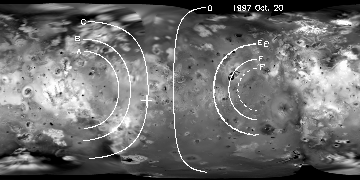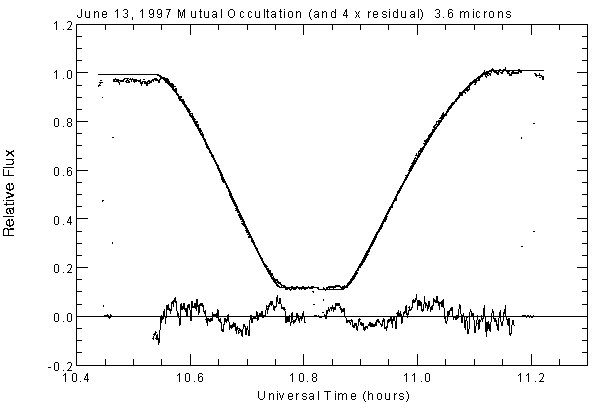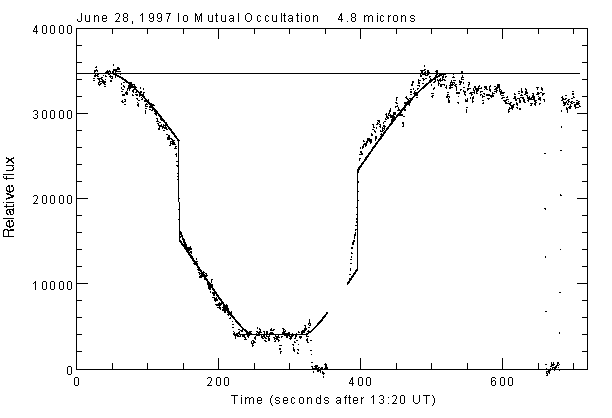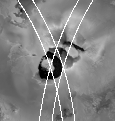
Io is the most volcanically active body in the solar system. It provides a unique laboratory for the study of volcanism under unusual conditions, for the study of the process of "tidal heating" in the outer solar system, and also for the study of planetary magnetospheres -- in this case derived from volcanically released sulfur dioxide. Observations from the earth can complement the observations being made by the Galileo spacecraft currently in Jupiter orbit. In the infrared a significant portion of the light from Io comes from the volcanic hotspots. Infrared monitoring can therefore be used to study the location, duration, and other characteristics of the volcanoes.
Even at closest approach to earth the disk of Io only reaches an apparent diameter of 1.2 arcseconds. Although some information about the spatial distribution of hotspots can be obtained by direct imaging, the highest angular resolution information comes from photometry obtained during occultations by Jupiter or by other satellites.
Julie Rathbun (of the Planetary Science Instutute) and I have a grant from the NASA PDART program, running from 2016-2019, to calibrate and place in the NASA Planetary Data System archives the IoCam1 Jupiter and mutual event occultations described below as well as similar observations obtained by Julie and John Spencer. Recent improvements in the ephemeris (orbital predictions) for the Galilean satellites, makes it possible to reanalyze this data set to obtain more precise identification of volcanic hotspots and their locations, and more details of the emission within the Loki hotspot.
A link to details of IoCam1, used for most of the following observations.
A link to results of those Io observations.
An occultation of Io by Jupiter occurs every Io orbit (1.7 days) and observations can be made while Io is in the shadow of Jupiter. The absence of sunlight makes it possible to detect very faint hot spots. However because of the fuzzy edge of the Jupiter atmosphere, the resolution obtained is limited. For observations made after Jupiter opposition Io is in eclipse as it reappears from behind the planet and each discrete jump in brightness corresponds to the reappearance of a volcanic hot spot. The following data were obtained from WIRO on Oct. 20, 1997 UT.

In the above plot the smooth line is a model comprised of 6 hotspots labeled A through F. The shape of the lightcurve for an individual spot is known a priori, from characteristics of the Jupiter atmosphere and the velocity of Io relative to Jupiter. The position, brightness, and number of spots are fit from the data. Bright hot spots such as C, D, E, and F can be well characterized. The fainter ones (A and B) probably represent composites of several fainter hot spots present on the satellite. The data beyond F is noisy because in producing the light curve from the recorded images we are using a small effective aperture, and once the full satellite has reappeared seeing noise causes some flux to be lost outside that aperture. Use of larger software apertures gives a more stable signal after full reappearance, but the increased noise from background thermal radiation degrades the more important early part of the lightcurve.

The location of the hot spots can be obtained by drawing the location of the limb of Jupiter at the time of reappearance on a map of the satellite. The hot spot must lie somewhere along that limb. In the above map the hot spot C apparently corresponds to "Kaneheliki", marked by the cross. This source was first detected by John Spencer at the NASA Infrared Telescope Facility (IRTF) using the Jupiter occultation technique, and the source appears to be the most stable of the bright ones present on Io. Source E probably corresponds to Ra or Amaterasu, and source F most likely corresponds to "Loki". At the time of this observation Loki was cooling off after a major eruption which occurred during the spring and summer of 1997.
Twice every Jupiter orbit (i.e. every 6 years) the Earth passes through the equatorial plane of Jupiter and the satellites can eclipse and occult each other in a series of mutual events. During occultations of Io by the other satellites the sharp edge presented by the occulting satellite permits very high angular resolution, but sunlight limits the ability to see faint hotspots.
On June 13, 1997 Io was occulted by Ganymede and observations were obtained at the Perkins 72" telescope at Lowell Observatory. At the 3.6 micron wavelength used Io contributes approximately 90% of the flux and, because water ice is dark, Ganymede contributes only 10%. The photometry (small dots) closely matches the model (solid line) expected when one uniform disk occults another. There are no sudden drops or jumps in the lightcurve which would indicate the presence of small bright volcanic hotspots. The leading hemisphere of Io, which was occulted during this event, was apparently relatively inactive.
To better show the differences between the model and the data, the residual, multiplied by 4, is shown below the photometry curve. The smoothly varying component of the residual is presumably due to albedo features on Io.

On June 28, 1997 Io was again occulted by Ganymede, but during this event the very
active trailing hemisphere was visible. A major eruption in the Loki region had been
detected earlier in the spring by ground-based observers. In addition, Galileo was flying
by Callisto and was also obtaining Io observations. Data were obtained with IoCam1 at the
Wyoming 92" telescope (WIRO), this time at the slightly longer wavelength of 4.8
microns. The sharp drop in flux at the 140 second mark corresponds to the disappearance of
Loki. It reappears at approximately 400 seconds. (The gap between 330 and 380 seconds
represents a short interruption in the data taking.) Although not yet included in the
model (the smooth line) the fainter "Pillan" hot spot can be seen to disappear
at approximately 220 seconds. The reappearance point is less clear, but that appears to
occur at approximately 480 seconds. The drop in flux after the occultation is over
corresponds to Ganymede moving partially out of the synthetic aperture used to produce
this preliminary photometry.
 The disappearance and reappearance of Loki
is not instantaneous but rather takes approximately 5 seconds. When the limb of
Ganymede is plotted on an Io map at the start and end of the Loki disappearance, and the
start and end of the reappearance, one obtains a central diamond shaped region where the
curves intersect. The hot spot is located within this diamond, and must extend to
touch its sides. In this case the hot spot is clearly located within the dark
"caldera" observed in 1979 by Voyager, and the hot region has a diameter of
roughly 100 kilometers. The area covered and the flow rate implied are comparable to
that expected for flood basalt eruptions on the earth.
The disappearance and reappearance of Loki
is not instantaneous but rather takes approximately 5 seconds. When the limb of
Ganymede is plotted on an Io map at the start and end of the Loki disappearance, and the
start and end of the reappearance, one obtains a central diamond shaped region where the
curves intersect. The hot spot is located within this diamond, and must extend to
touch its sides. In this case the hot spot is clearly located within the dark
"caldera" observed in 1979 by Voyager, and the hot region has a diameter of
roughly 100 kilometers. The area covered and the flow rate implied are comparable to
that expected for flood basalt eruptions on the earth.
back to Robert Howell's home page
Last revised: March 6, 2018.